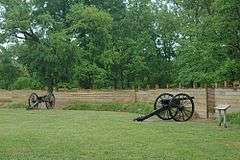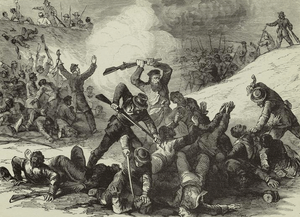Fort Pillow State Historic Park
| Fort Pillow State Historic Park | |
|---|---|
 Cannons at Fort Pillow in 2006 | |
| Type | Tennessee State Park |
| Location | Henning, Tennessee |
| Area | 1,642 acres (6.64 km2) |
| Created | 1971 |
| Open |
Year round |
|
Fort Pillow | |
  | |
| Location | TN State Route 87, Lauderdale County, Tennessee |
| Nearest city | Osceola, Arkansas |
| Coordinates | 35°38′10″N 89°50′32″W / 35.63611°N 89.84222°WCoordinates: 35°38′10″N 89°50′32″W / 35.63611°N 89.84222°W |
| Built | 1861 |
| NRHP reference # | 73001806 |
| Significant dates | |
| Added to NRHP | April 11, 1973[1] |
| Designated NHL | May 30, 1974[2] |
Fort Pillow State Historic Park is a state park in western Tennessee that preserves the American Civil War site of the Battle of Fort Pillow. The 1,642 acre (6.6 km²) Fort Pillow, located in Lauderdale County on the Chickasaw Bluffs overlooking the Mississippi River, is rich in both historic and archaeological significance. In 1861, the Confederate army built extensive fortifications and named the site for General Gideon Johnson Pillow of Maury County. It was attacked and held by the Union Army for most of the American Civil War period except immediately after the Battle of Fort Pillow, when it was retaken by the Confederate Army. Many African-American soldiers were killed in what modern historians describe as a "massacre" or "atrocity". Interpretive sites are part of the park.
Union fort, and Battle of Fort Pillow

Because of its strategic location controlling traffic on the Mississippi River, the fort was attacked and captured by the Union Army, which controlled it during most of the war. On June 4, 1862, Confederate troops evacuated Fort Pillow, enabling Union troops to take Memphis, Tennessee. An exception to Union control of this site took place for less than one day immediately after the Confederate victory in the Battle of Fort Pillow in 1864.
The Confederate States Army defeated the Union troops at the Battle of Fort Pillow (April 1864), resulting in the massacre of 229 of the 262 black Union soldiers engaged in the battle.[3] The white Union soldiers numbered 285. An examination of regimental records showed that "less than 36 percent of the men from white units died in battle or of wounds, while the death toll for black units was 66 percent."[4]
A Confederate wrote in a letter home that "Forrest ordered them [negroes] shot down like dogs, and the carnage continued."[5] In addition to regimental records, contemporary accounts by troops on both sides, as well as journalists, describe it as appalling slaughter.[6] Within about three weeks, as political controversy grew, Confederates began to dispute accounts of a massacre.[7] This slaughter by the Confederate troops under Gen. Nathan Bedford Forrest has been classified by historians as a massacre. Confederate apologists debate the fatality numbers.
"Remember Fort Pillow!" became a battle cry among black Union soldiers for the remainder of the Civil War. While the Union casualty count for the battle does not indicate that the Confederate forces took many prisoners, Confederate records show about 200 prisoners were shipped south.
In 1866, the Union Army created a cemetery for both Confederate and Union soldiers south of the battle site. In 1867, they moved about 250 bodies of Confederate and Union soldiers from that cemetery to the Memphis National Cemetery.[8]
Historic site and museum
In 1973, the site was added to the National Register of Historic Places.[1][9] It was designated as a National Historic Landmark in 1974.[10][11] Remains of the fort's earthworks were well-preserved as of 2011.
The park has an interpretive center and museum (open 8 a.m. – 4 p.m. daily, except for certain holidays). Tours of the museum and restored fortifications are available upon request. The park also offers many recreational activities, including camping, picnicking and fishing.
See also
References
| Wikimedia Commons has media related to Fort Pillow State Historic Park. |
- 1 2 National Park Service (2008-04-15). "National Register Information System". National Register of Historic Places. National Park Service.
- ↑ "Fort Pillow". National Historic Landmark summary listing. National Park Service. Retrieved 2008-06-27.
- ↑ , National Park Service
- ↑ John Cimprich and Robert C. Mainfort, Jr., "Fort Pillow Revisited", 1982, in Race and Recruitment, ed. John David Smith, Kent State University Press, 2013, p. 214
- ↑ Cimprich and Mainfort (1982), "Fort Pillow Revisited", p. 219
- ↑ Cimprich and Mainfort (1982), "Fort Pillow Revisited", pp. 216-225
- ↑ Cimprich and Mainfort (1982), "Fort Pillow Revisited", p. 226
- ↑ Cimprich, John (2005). Fort Pillow, a Civil War Massacre, and Public Memory. Baton Rouge, LA: LSU Press. p. 193. ISBN 0-8071-3110-5.
- ↑ http://www.nationalregisterofhistoricplaces.com National Register of Historic Places
- ↑ Marcia M. Green!ee, The Afro-American Bicentennial Corporation (February 1973). "National Register of Historic Places Inventory – Nomination Form" (PDF). Washington, D.C.: National Park Service. Retrieved 8 May 2018.
- ↑ Peter LaPaglia (February 1973). "National Register of Historic Places Property Photograph Form: Site of Fort Pillow, Tenn., facing northwest;Section of inner fort wall, taken from center of fort location" (PDF). National Park Service. Retrieved 8 May 2018.